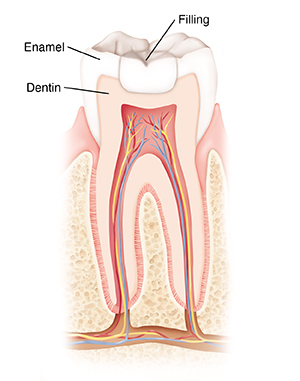A
B
C
D
E
F
G
H
I
J
K
L
M
N
O
P
Q
R
S
T
U
V
W
X
Y
Z
Click a letter to see a list of conditions beginning with that letter.
Click 'Topic Index' to return to the index for the current topic.
Click 'Library Index' to return to the listing of all topics.
Understanding Tooth Decay
Plaque is a sticky coating of bacteria and other substances that forms on your teeth and gums. It can cause 2 serious problems: tooth decay and gum disease. These problems damage the teeth and gums. They may even lead to tooth loss. When the mouth is well cared for, tooth decay and gum disease can be reversed in their early stages. Better yet, you can prevent these problems from starting by:
-
Brushing at least twice a day and flossing daily
-
Maintaining a healthy diet
-
Not snacking between meals on foods high in sugar and starch
How tooth decay occurs
Tooth decay happens when bacteria in plaque make acids that eat away at the tooth. Cavities (also called caries) are holes that form in the teeth. They are most common in places that are hard to reach with a toothbrush. This includes the grooves at the tops of the back teeth, and on the sides where the teeth touch. In late stages, tooth decay can be painful. It can also lead to tooth loss.
Treating tooth decay
Tooth decay can be treated to keep it from moving farther into the tooth. This is often done by filling cavities. First any tooth decay is removed. This protects the tooth from more damage. Then the cavity is filled with a hard material. This filling protects the damaged tooth and restores the tooth's surface. If the tooth is severely damaged by decay, other treatments are available.
 |
| Once tooth decay eats through the enamel, it can spread quickly through the softer dentin. |
 |
| After tooth decay is removed, the hole is filled with a hard material. |
Follow-up visits
Visit your dental team at least every 6 months for a checkup and cleaning. If you’re being treated for tooth decay or gum disease, you may need more frequent visits. These visits will likely decrease as your mouth care efforts start to pay off. Keep flossing and brushing, and maintain a healthy diet. Follow any special instructions your dentist or dental hygienist gives you. And enjoy flashing your healthy smile!
Online Medical Reviewer:
Jessica Gotwals RN BSN MPH
Online Medical Reviewer:
Michael Kapner MD
Online Medical Reviewer:
Tennille Dozier RN BSN RDMS
Date Last Reviewed:
12/1/2022
© 2000-2024 The StayWell Company, LLC. All rights reserved. This information is not intended as a substitute for professional medical care. Always follow your healthcare professional's instructions.